NURS13137: Diabetes Mellitus Education and Management Report
VerifiedAdded on 2023/06/12
|12
|2407
|127
Report
AI Summary
This report focuses on diabetes mellitus education for management, particularly targeting indigenous Australians as a key population within the Australian National Health Priority Areas (NHPA). It addresses the increasing prevalence of diabetes across all demographics and emphasizes the importance of tailored care and ongoing research. The report examines the roles of various stakeholders in diabetes care and treatment, highlighting the use of Clinical Practice Guidelines (CPGs) to improve diagnosis, prognosis, and therapeutic recommendations. It also discusses the collaborative efforts of organizations like the Australian Diabetes Association and the Department of Disease Control in developing evidence-based recommendations for medical practitioners. The report concludes by acknowledging the complexities and potential setbacks in implementing these guidelines, such as cost concerns, while emphasizing the importance of continued advancements in diabetes care.
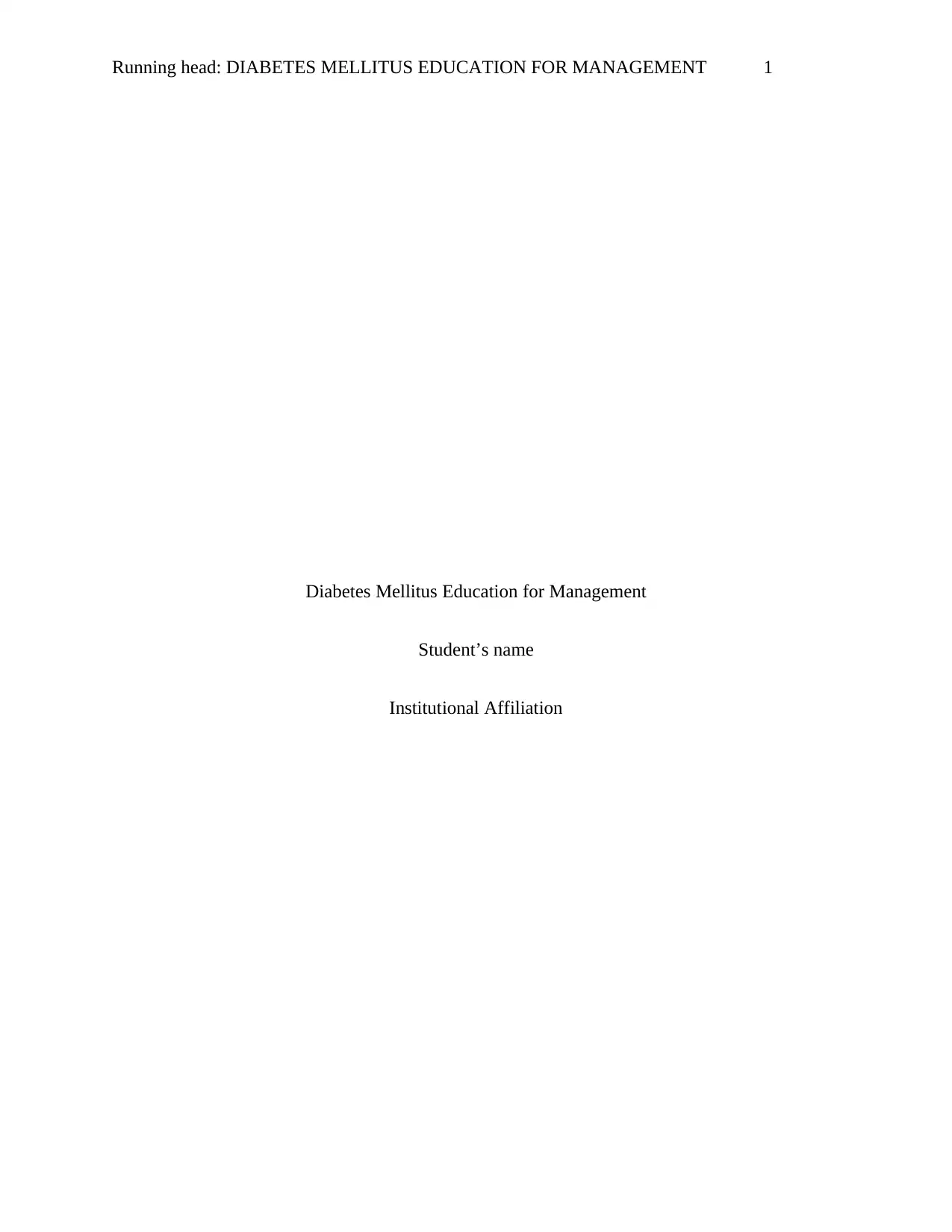
Running head: DIABETES MELLITUS EDUCATION FOR MANAGEMENT 1
Diabetes Mellitus Education for Management
Student’s name
Institutional Affiliation
Diabetes Mellitus Education for Management
Student’s name
Institutional Affiliation
Paraphrase This Document
Need a fresh take? Get an instant paraphrase of this document with our AI Paraphraser
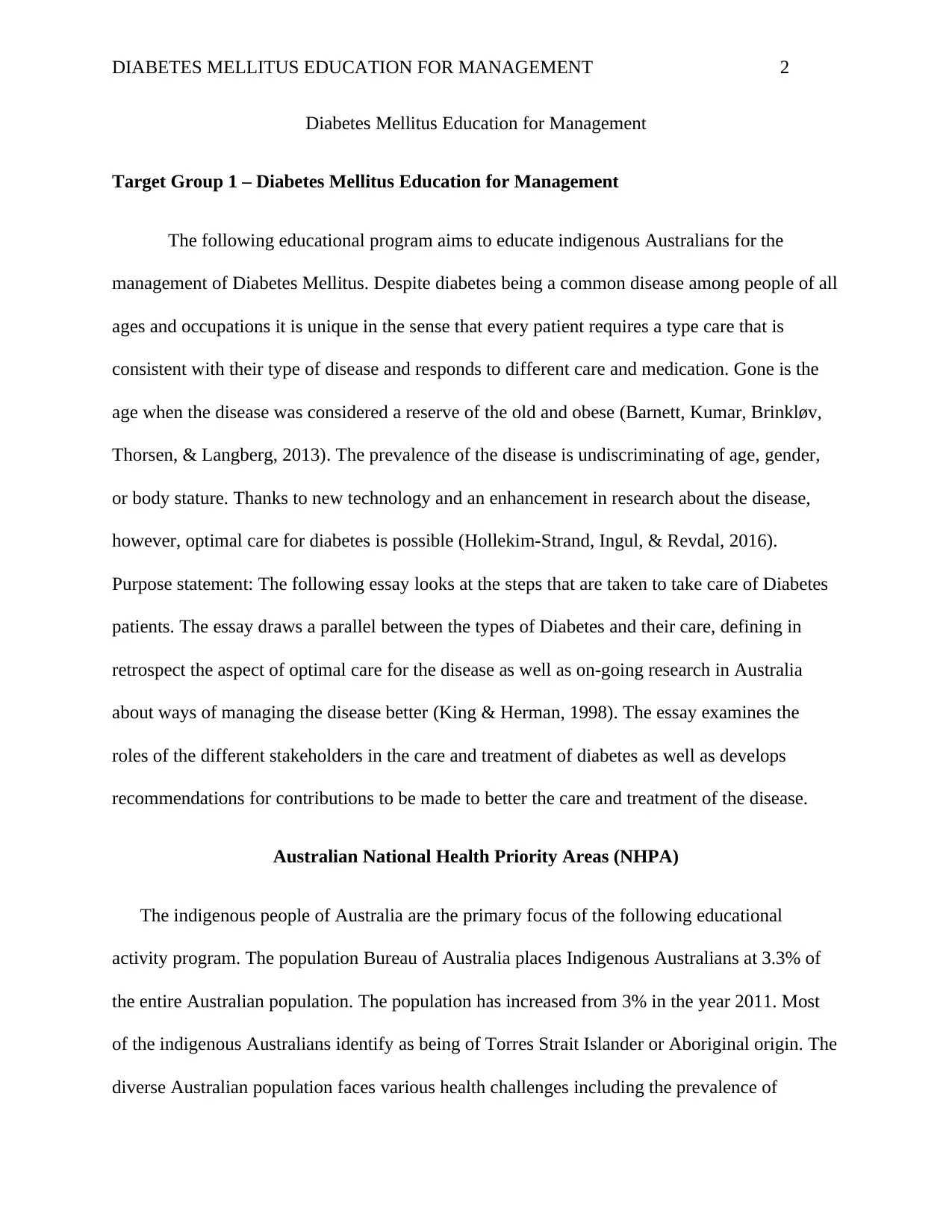
DIABETES MELLITUS EDUCATION FOR MANAGEMENT 2
Diabetes Mellitus Education for Management
Target Group 1 – Diabetes Mellitus Education for Management
The following educational program aims to educate indigenous Australians for the
management of Diabetes Mellitus. Despite diabetes being a common disease among people of all
ages and occupations it is unique in the sense that every patient requires a type care that is
consistent with their type of disease and responds to different care and medication. Gone is the
age when the disease was considered a reserve of the old and obese (Barnett, Kumar, Brinkløv,
Thorsen, & Langberg, 2013). The prevalence of the disease is undiscriminating of age, gender,
or body stature. Thanks to new technology and an enhancement in research about the disease,
however, optimal care for diabetes is possible (Hollekim-Strand, Ingul, & Revdal, 2016).
Purpose statement: The following essay looks at the steps that are taken to take care of Diabetes
patients. The essay draws a parallel between the types of Diabetes and their care, defining in
retrospect the aspect of optimal care for the disease as well as on-going research in Australia
about ways of managing the disease better (King & Herman, 1998). The essay examines the
roles of the different stakeholders in the care and treatment of diabetes as well as develops
recommendations for contributions to be made to better the care and treatment of the disease.
Australian National Health Priority Areas (NHPA)
The indigenous people of Australia are the primary focus of the following educational
activity program. The population Bureau of Australia places Indigenous Australians at 3.3% of
the entire Australian population. The population has increased from 3% in the year 2011. Most
of the indigenous Australians identify as being of Torres Strait Islander or Aboriginal origin. The
diverse Australian population faces various health challenges including the prevalence of
Diabetes Mellitus Education for Management
Target Group 1 – Diabetes Mellitus Education for Management
The following educational program aims to educate indigenous Australians for the
management of Diabetes Mellitus. Despite diabetes being a common disease among people of all
ages and occupations it is unique in the sense that every patient requires a type care that is
consistent with their type of disease and responds to different care and medication. Gone is the
age when the disease was considered a reserve of the old and obese (Barnett, Kumar, Brinkløv,
Thorsen, & Langberg, 2013). The prevalence of the disease is undiscriminating of age, gender,
or body stature. Thanks to new technology and an enhancement in research about the disease,
however, optimal care for diabetes is possible (Hollekim-Strand, Ingul, & Revdal, 2016).
Purpose statement: The following essay looks at the steps that are taken to take care of Diabetes
patients. The essay draws a parallel between the types of Diabetes and their care, defining in
retrospect the aspect of optimal care for the disease as well as on-going research in Australia
about ways of managing the disease better (King & Herman, 1998). The essay examines the
roles of the different stakeholders in the care and treatment of diabetes as well as develops
recommendations for contributions to be made to better the care and treatment of the disease.
Australian National Health Priority Areas (NHPA)
The indigenous people of Australia are the primary focus of the following educational
activity program. The population Bureau of Australia places Indigenous Australians at 3.3% of
the entire Australian population. The population has increased from 3% in the year 2011. Most
of the indigenous Australians identify as being of Torres Strait Islander or Aboriginal origin. The
diverse Australian population faces various health challenges including the prevalence of
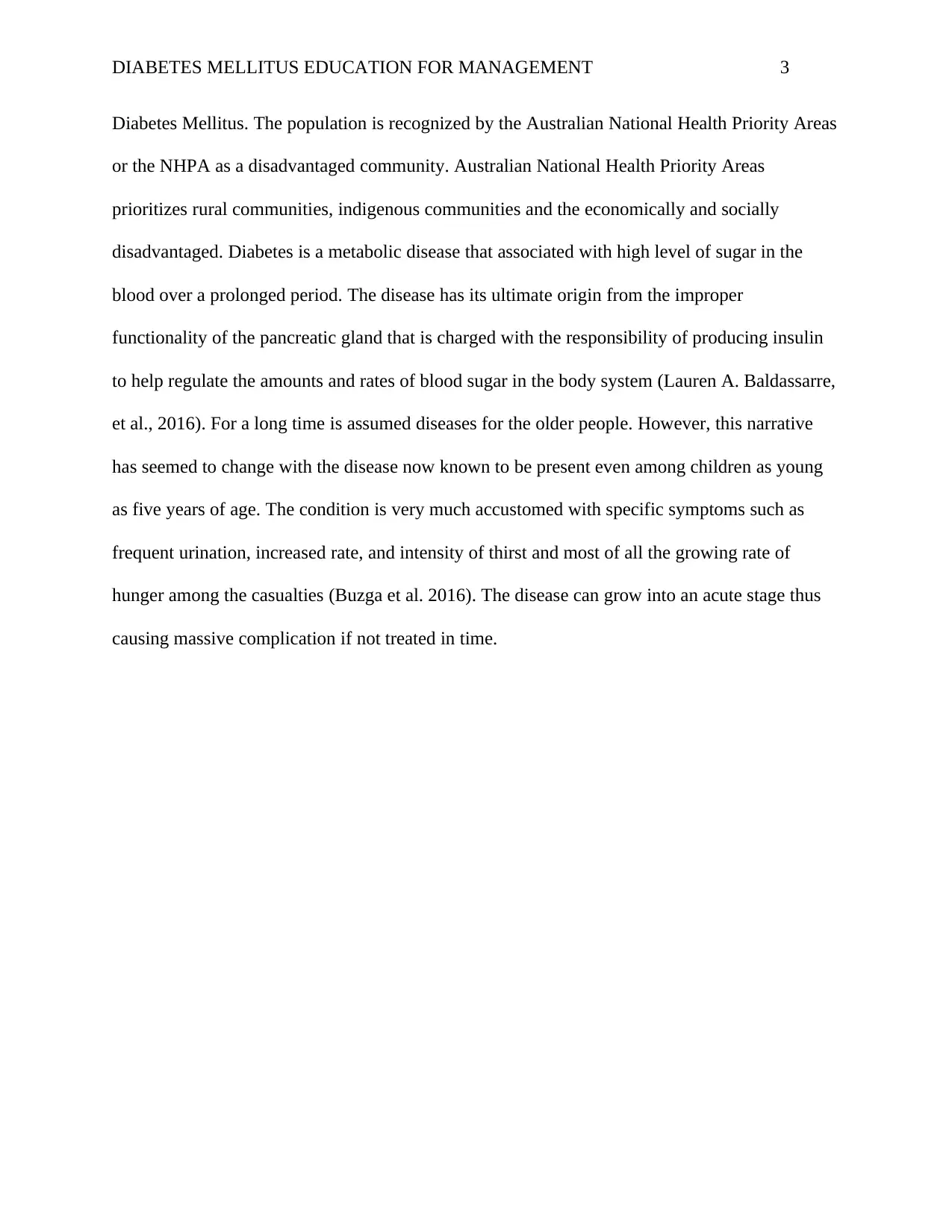
DIABETES MELLITUS EDUCATION FOR MANAGEMENT 3
Diabetes Mellitus. The population is recognized by the Australian National Health Priority Areas
or the NHPA as a disadvantaged community. Australian National Health Priority Areas
prioritizes rural communities, indigenous communities and the economically and socially
disadvantaged. Diabetes is a metabolic disease that associated with high level of sugar in the
blood over a prolonged period. The disease has its ultimate origin from the improper
functionality of the pancreatic gland that is charged with the responsibility of producing insulin
to help regulate the amounts and rates of blood sugar in the body system (Lauren A. Baldassarre,
et al., 2016). For a long time is assumed diseases for the older people. However, this narrative
has seemed to change with the disease now known to be present even among children as young
as five years of age. The condition is very much accustomed with specific symptoms such as
frequent urination, increased rate, and intensity of thirst and most of all the growing rate of
hunger among the casualties (Buzga et al. 2016). The disease can grow into an acute stage thus
causing massive complication if not treated in time.
Diabetes Mellitus. The population is recognized by the Australian National Health Priority Areas
or the NHPA as a disadvantaged community. Australian National Health Priority Areas
prioritizes rural communities, indigenous communities and the economically and socially
disadvantaged. Diabetes is a metabolic disease that associated with high level of sugar in the
blood over a prolonged period. The disease has its ultimate origin from the improper
functionality of the pancreatic gland that is charged with the responsibility of producing insulin
to help regulate the amounts and rates of blood sugar in the body system (Lauren A. Baldassarre,
et al., 2016). For a long time is assumed diseases for the older people. However, this narrative
has seemed to change with the disease now known to be present even among children as young
as five years of age. The condition is very much accustomed with specific symptoms such as
frequent urination, increased rate, and intensity of thirst and most of all the growing rate of
hunger among the casualties (Buzga et al. 2016). The disease can grow into an acute stage thus
causing massive complication if not treated in time.
⊘ This is a preview!⊘
Do you want full access?
Subscribe today to unlock all pages.

Trusted by 1+ million students worldwide
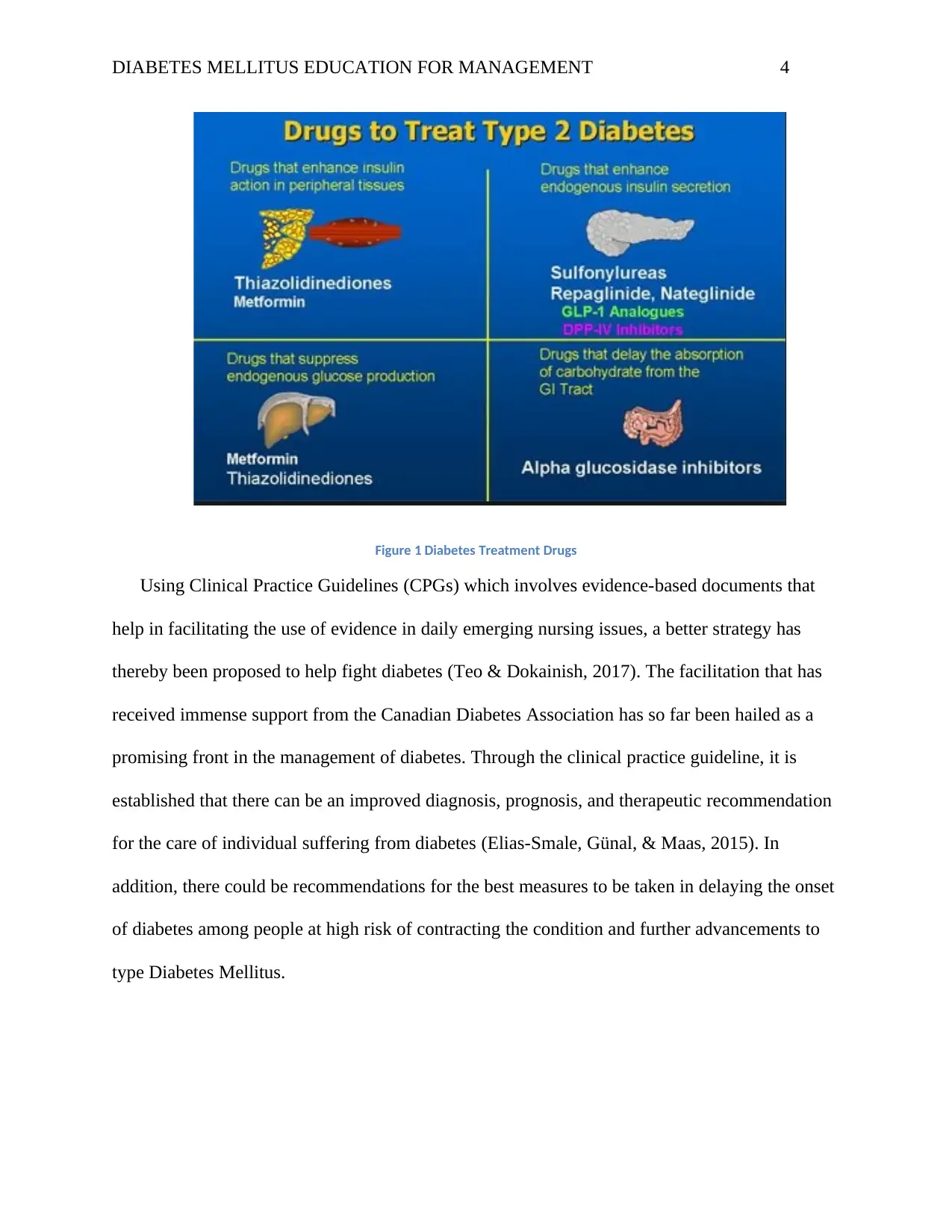
DIABETES MELLITUS EDUCATION FOR MANAGEMENT 4
Figure 1 Diabetes Treatment Drugs
Using Clinical Practice Guidelines (CPGs) which involves evidence-based documents that
help in facilitating the use of evidence in daily emerging nursing issues, a better strategy has
thereby been proposed to help fight diabetes (Teo & Dokainish, 2017). The facilitation that has
received immense support from the Canadian Diabetes Association has so far been hailed as a
promising front in the management of diabetes. Through the clinical practice guideline, it is
established that there can be an improved diagnosis, prognosis, and therapeutic recommendation
for the care of individual suffering from diabetes (Elias-Smale, Günal, & Maas, 2015). In
addition, there could be recommendations for the best measures to be taken in delaying the onset
of diabetes among people at high risk of contracting the condition and further advancements to
type Diabetes Mellitus.
Figure 1 Diabetes Treatment Drugs
Using Clinical Practice Guidelines (CPGs) which involves evidence-based documents that
help in facilitating the use of evidence in daily emerging nursing issues, a better strategy has
thereby been proposed to help fight diabetes (Teo & Dokainish, 2017). The facilitation that has
received immense support from the Canadian Diabetes Association has so far been hailed as a
promising front in the management of diabetes. Through the clinical practice guideline, it is
established that there can be an improved diagnosis, prognosis, and therapeutic recommendation
for the care of individual suffering from diabetes (Elias-Smale, Günal, & Maas, 2015). In
addition, there could be recommendations for the best measures to be taken in delaying the onset
of diabetes among people at high risk of contracting the condition and further advancements to
type Diabetes Mellitus.
Paraphrase This Document
Need a fresh take? Get an instant paraphrase of this document with our AI Paraphraser
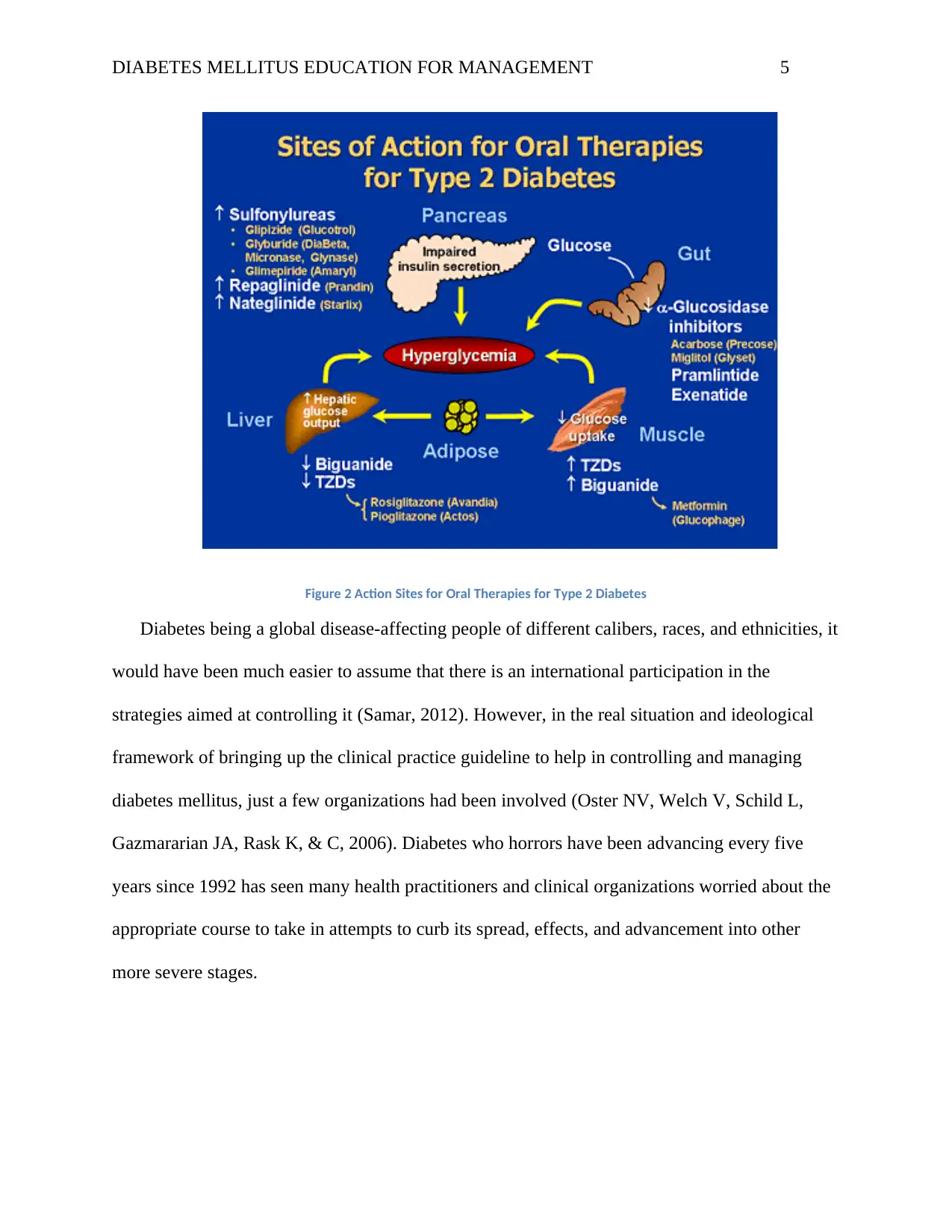
DIABETES MELLITUS EDUCATION FOR MANAGEMENT 5
Figure 2 Action Sites for Oral Therapies for Type 2 Diabetes
Diabetes being a global disease-affecting people of different calibers, races, and ethnicities, it
would have been much easier to assume that there is an international participation in the
strategies aimed at controlling it (Samar, 2012). However, in the real situation and ideological
framework of bringing up the clinical practice guideline to help in controlling and managing
diabetes mellitus, just a few organizations had been involved (Oster NV, Welch V, Schild L,
Gazmararian JA, Rask K, & C, 2006). Diabetes who horrors have been advancing every five
years since 1992 has seen many health practitioners and clinical organizations worried about the
appropriate course to take in attempts to curb its spread, effects, and advancement into other
more severe stages.
Figure 2 Action Sites for Oral Therapies for Type 2 Diabetes
Diabetes being a global disease-affecting people of different calibers, races, and ethnicities, it
would have been much easier to assume that there is an international participation in the
strategies aimed at controlling it (Samar, 2012). However, in the real situation and ideological
framework of bringing up the clinical practice guideline to help in controlling and managing
diabetes mellitus, just a few organizations had been involved (Oster NV, Welch V, Schild L,
Gazmararian JA, Rask K, & C, 2006). Diabetes who horrors have been advancing every five
years since 1992 has seen many health practitioners and clinical organizations worried about the
appropriate course to take in attempts to curb its spread, effects, and advancement into other
more severe stages.
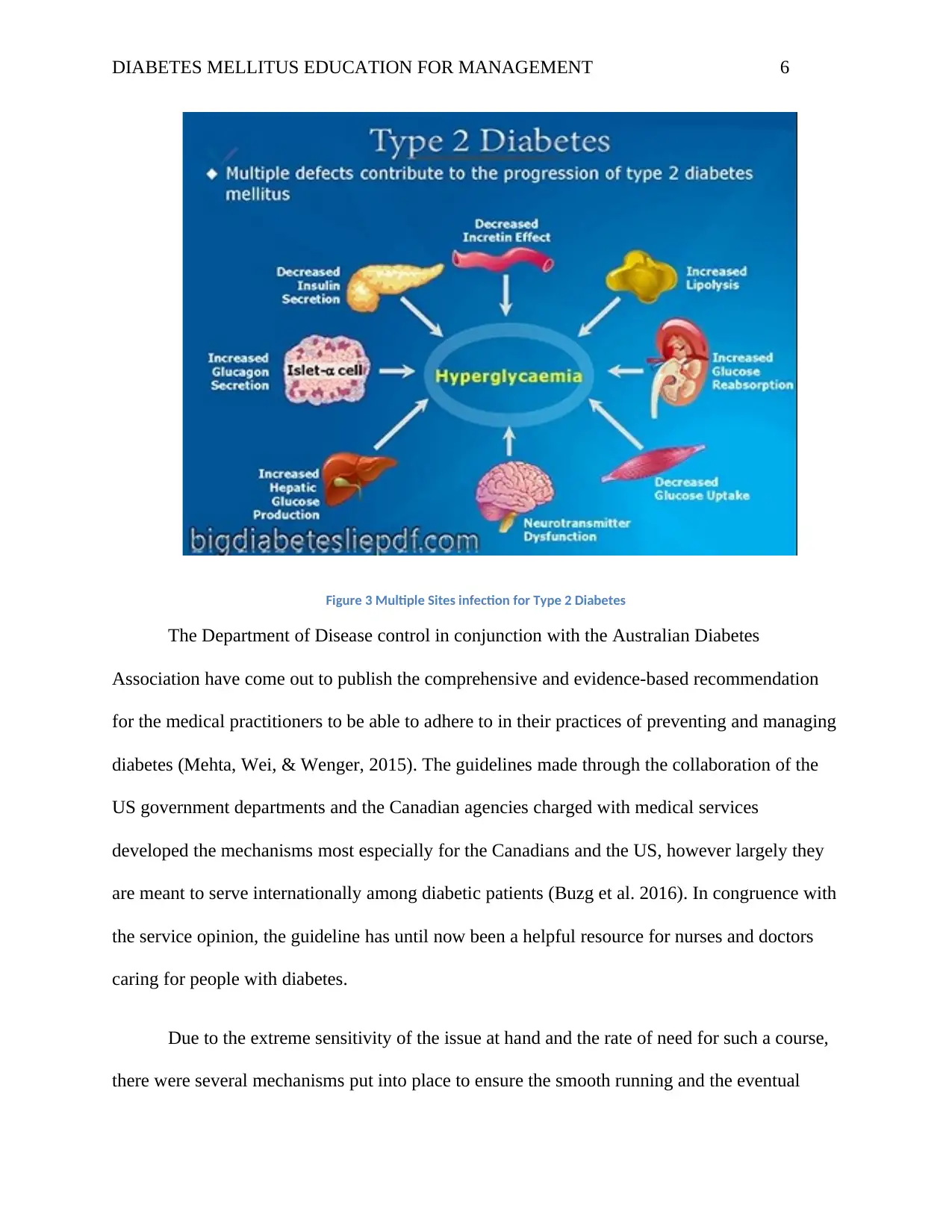
DIABETES MELLITUS EDUCATION FOR MANAGEMENT 6
Figure 3 Multiple Sites infection for Type 2 Diabetes
The Department of Disease control in conjunction with the Australian Diabetes
Association have come out to publish the comprehensive and evidence-based recommendation
for the medical practitioners to be able to adhere to in their practices of preventing and managing
diabetes (Mehta, Wei, & Wenger, 2015). The guidelines made through the collaboration of the
US government departments and the Canadian agencies charged with medical services
developed the mechanisms most especially for the Canadians and the US, however largely they
are meant to serve internationally among diabetic patients (Buzg et al. 2016). In congruence with
the service opinion, the guideline has until now been a helpful resource for nurses and doctors
caring for people with diabetes.
Due to the extreme sensitivity of the issue at hand and the rate of need for such a course,
there were several mechanisms put into place to ensure the smooth running and the eventual
Figure 3 Multiple Sites infection for Type 2 Diabetes
The Department of Disease control in conjunction with the Australian Diabetes
Association have come out to publish the comprehensive and evidence-based recommendation
for the medical practitioners to be able to adhere to in their practices of preventing and managing
diabetes (Mehta, Wei, & Wenger, 2015). The guidelines made through the collaboration of the
US government departments and the Canadian agencies charged with medical services
developed the mechanisms most especially for the Canadians and the US, however largely they
are meant to serve internationally among diabetic patients (Buzg et al. 2016). In congruence with
the service opinion, the guideline has until now been a helpful resource for nurses and doctors
caring for people with diabetes.
Due to the extreme sensitivity of the issue at hand and the rate of need for such a course,
there were several mechanisms put into place to ensure the smooth running and the eventual
⊘ This is a preview!⊘
Do you want full access?
Subscribe today to unlock all pages.

Trusted by 1+ million students worldwide
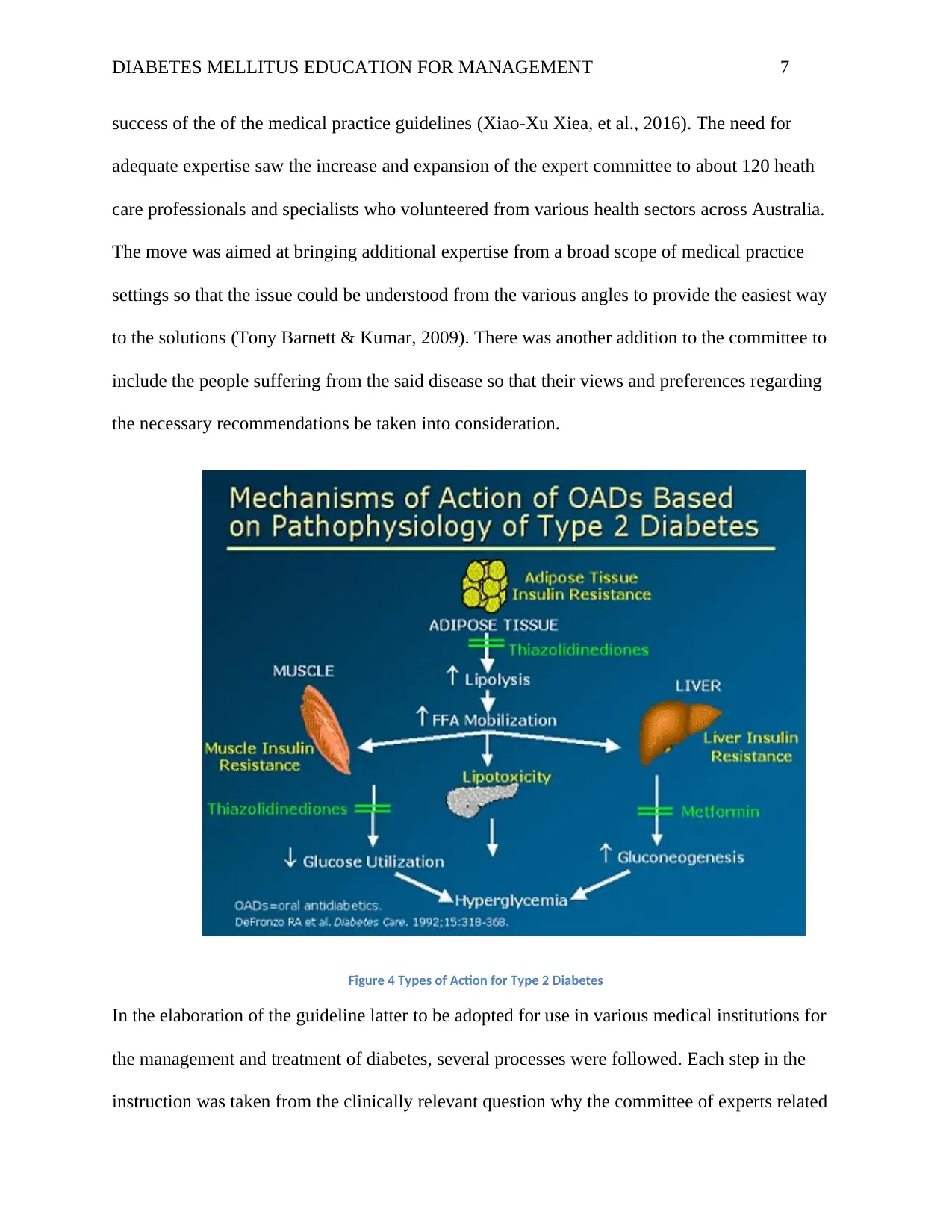
DIABETES MELLITUS EDUCATION FOR MANAGEMENT 7
success of the of the medical practice guidelines (Xiao-Xu Xiea, et al., 2016). The need for
adequate expertise saw the increase and expansion of the expert committee to about 120 heath
care professionals and specialists who volunteered from various health sectors across Australia.
The move was aimed at bringing additional expertise from a broad scope of medical practice
settings so that the issue could be understood from the various angles to provide the easiest way
to the solutions (Tony Barnett & Kumar, 2009). There was another addition to the committee to
include the people suffering from the said disease so that their views and preferences regarding
the necessary recommendations be taken into consideration.
Figure 4 Types of Action for Type 2 Diabetes
In the elaboration of the guideline latter to be adopted for use in various medical institutions for
the management and treatment of diabetes, several processes were followed. Each step in the
instruction was taken from the clinically relevant question why the committee of experts related
success of the of the medical practice guidelines (Xiao-Xu Xiea, et al., 2016). The need for
adequate expertise saw the increase and expansion of the expert committee to about 120 heath
care professionals and specialists who volunteered from various health sectors across Australia.
The move was aimed at bringing additional expertise from a broad scope of medical practice
settings so that the issue could be understood from the various angles to provide the easiest way
to the solutions (Tony Barnett & Kumar, 2009). There was another addition to the committee to
include the people suffering from the said disease so that their views and preferences regarding
the necessary recommendations be taken into consideration.
Figure 4 Types of Action for Type 2 Diabetes
In the elaboration of the guideline latter to be adopted for use in various medical institutions for
the management and treatment of diabetes, several processes were followed. Each step in the
instruction was taken from the clinically relevant question why the committee of experts related
Paraphrase This Document
Need a fresh take? Get an instant paraphrase of this document with our AI Paraphraser
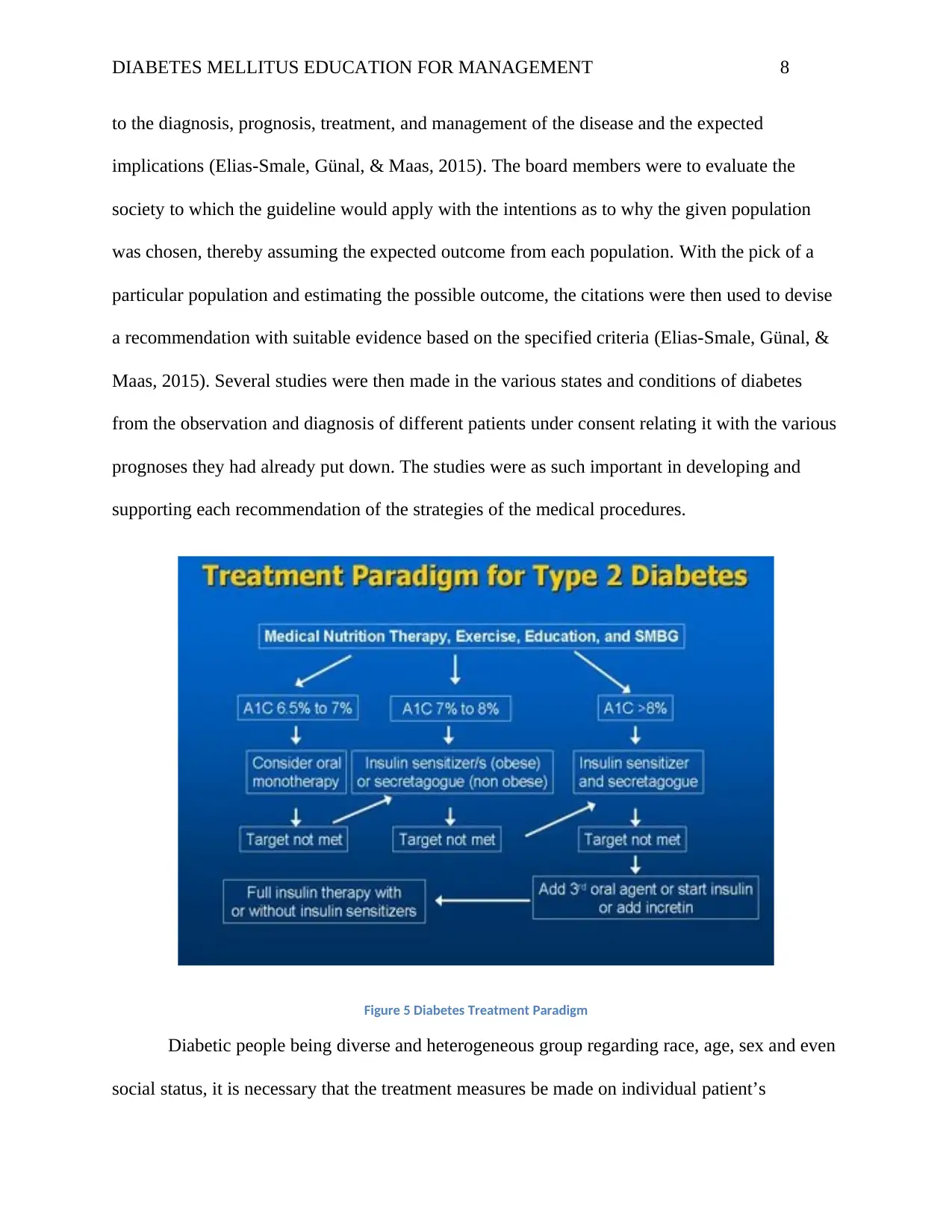
DIABETES MELLITUS EDUCATION FOR MANAGEMENT 8
to the diagnosis, prognosis, treatment, and management of the disease and the expected
implications (Elias-Smale, Günal, & Maas, 2015). The board members were to evaluate the
society to which the guideline would apply with the intentions as to why the given population
was chosen, thereby assuming the expected outcome from each population. With the pick of a
particular population and estimating the possible outcome, the citations were then used to devise
a recommendation with suitable evidence based on the specified criteria (Elias-Smale, Günal, &
Maas, 2015). Several studies were then made in the various states and conditions of diabetes
from the observation and diagnosis of different patients under consent relating it with the various
prognoses they had already put down. The studies were as such important in developing and
supporting each recommendation of the strategies of the medical procedures.
Figure 5 Diabetes Treatment Paradigm
Diabetic people being diverse and heterogeneous group regarding race, age, sex and even
social status, it is necessary that the treatment measures be made on individual patient’s
to the diagnosis, prognosis, treatment, and management of the disease and the expected
implications (Elias-Smale, Günal, & Maas, 2015). The board members were to evaluate the
society to which the guideline would apply with the intentions as to why the given population
was chosen, thereby assuming the expected outcome from each population. With the pick of a
particular population and estimating the possible outcome, the citations were then used to devise
a recommendation with suitable evidence based on the specified criteria (Elias-Smale, Günal, &
Maas, 2015). Several studies were then made in the various states and conditions of diabetes
from the observation and diagnosis of different patients under consent relating it with the various
prognoses they had already put down. The studies were as such important in developing and
supporting each recommendation of the strategies of the medical procedures.
Figure 5 Diabetes Treatment Paradigm
Diabetic people being diverse and heterogeneous group regarding race, age, sex and even
social status, it is necessary that the treatment measures be made on individual patient’s
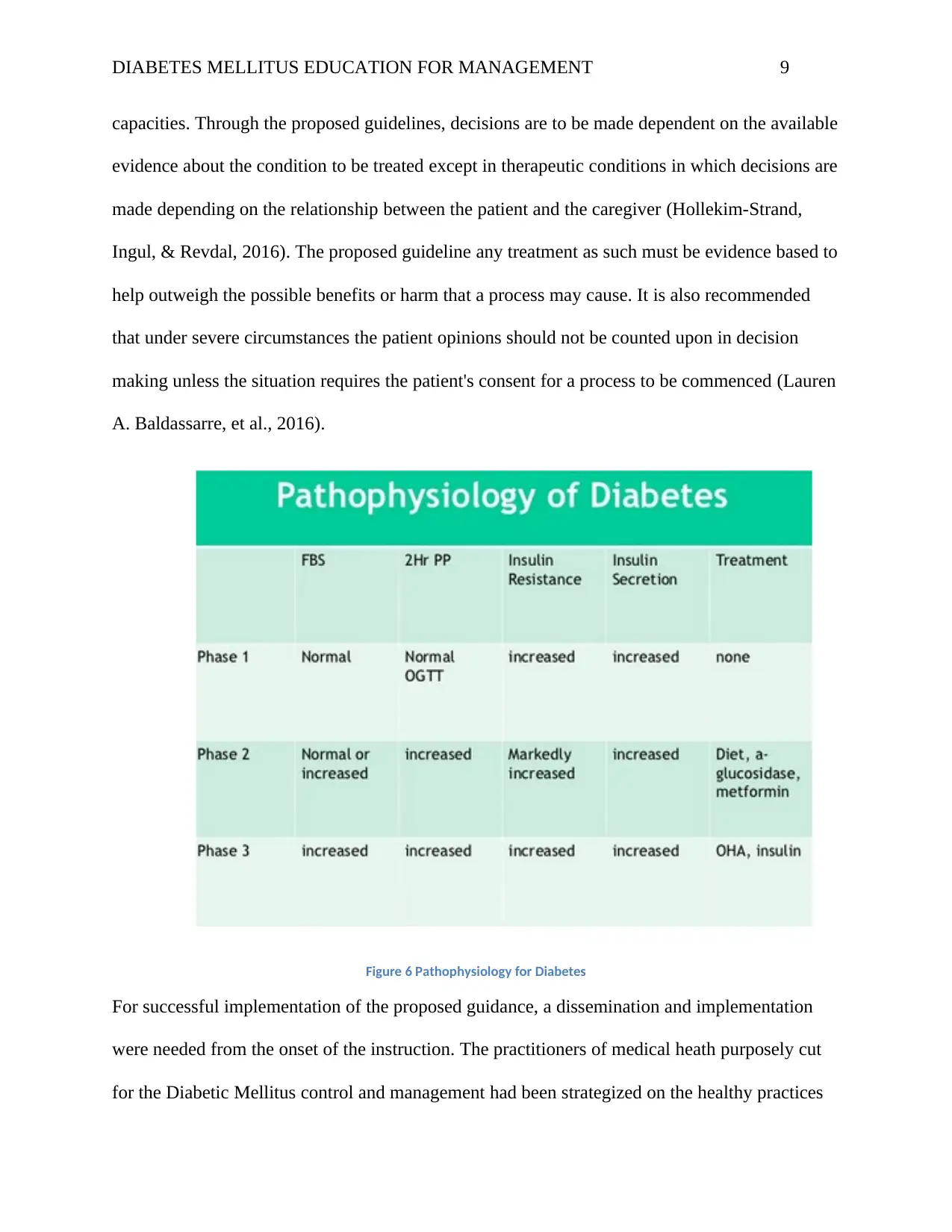
DIABETES MELLITUS EDUCATION FOR MANAGEMENT 9
capacities. Through the proposed guidelines, decisions are to be made dependent on the available
evidence about the condition to be treated except in therapeutic conditions in which decisions are
made depending on the relationship between the patient and the caregiver (Hollekim-Strand,
Ingul, & Revdal, 2016). The proposed guideline any treatment as such must be evidence based to
help outweigh the possible benefits or harm that a process may cause. It is also recommended
that under severe circumstances the patient opinions should not be counted upon in decision
making unless the situation requires the patient's consent for a process to be commenced (Lauren
A. Baldassarre, et al., 2016).
Figure 6 Pathophysiology for Diabetes
For successful implementation of the proposed guidance, a dissemination and implementation
were needed from the onset of the instruction. The practitioners of medical heath purposely cut
for the Diabetic Mellitus control and management had been strategized on the healthy practices
capacities. Through the proposed guidelines, decisions are to be made dependent on the available
evidence about the condition to be treated except in therapeutic conditions in which decisions are
made depending on the relationship between the patient and the caregiver (Hollekim-Strand,
Ingul, & Revdal, 2016). The proposed guideline any treatment as such must be evidence based to
help outweigh the possible benefits or harm that a process may cause. It is also recommended
that under severe circumstances the patient opinions should not be counted upon in decision
making unless the situation requires the patient's consent for a process to be commenced (Lauren
A. Baldassarre, et al., 2016).
Figure 6 Pathophysiology for Diabetes
For successful implementation of the proposed guidance, a dissemination and implementation
were needed from the onset of the instruction. The practitioners of medical heath purposely cut
for the Diabetic Mellitus control and management had been strategized on the healthy practices
⊘ This is a preview!⊘
Do you want full access?
Subscribe today to unlock all pages.

Trusted by 1+ million students worldwide
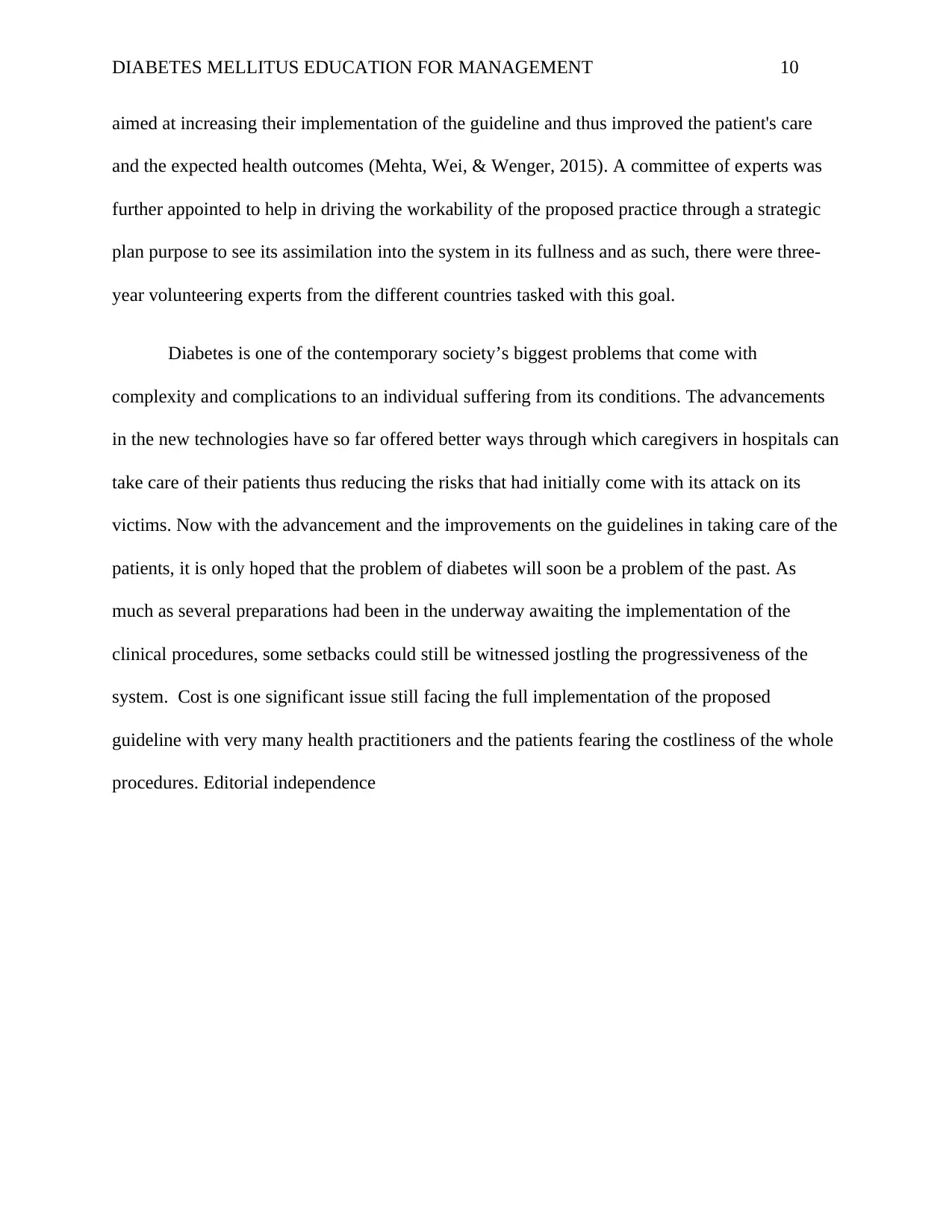
DIABETES MELLITUS EDUCATION FOR MANAGEMENT 10
aimed at increasing their implementation of the guideline and thus improved the patient's care
and the expected health outcomes (Mehta, Wei, & Wenger, 2015). A committee of experts was
further appointed to help in driving the workability of the proposed practice through a strategic
plan purpose to see its assimilation into the system in its fullness and as such, there were three-
year volunteering experts from the different countries tasked with this goal.
Diabetes is one of the contemporary society’s biggest problems that come with
complexity and complications to an individual suffering from its conditions. The advancements
in the new technologies have so far offered better ways through which caregivers in hospitals can
take care of their patients thus reducing the risks that had initially come with its attack on its
victims. Now with the advancement and the improvements on the guidelines in taking care of the
patients, it is only hoped that the problem of diabetes will soon be a problem of the past. As
much as several preparations had been in the underway awaiting the implementation of the
clinical procedures, some setbacks could still be witnessed jostling the progressiveness of the
system. Cost is one significant issue still facing the full implementation of the proposed
guideline with very many health practitioners and the patients fearing the costliness of the whole
procedures. Editorial independence
aimed at increasing their implementation of the guideline and thus improved the patient's care
and the expected health outcomes (Mehta, Wei, & Wenger, 2015). A committee of experts was
further appointed to help in driving the workability of the proposed practice through a strategic
plan purpose to see its assimilation into the system in its fullness and as such, there were three-
year volunteering experts from the different countries tasked with this goal.
Diabetes is one of the contemporary society’s biggest problems that come with
complexity and complications to an individual suffering from its conditions. The advancements
in the new technologies have so far offered better ways through which caregivers in hospitals can
take care of their patients thus reducing the risks that had initially come with its attack on its
victims. Now with the advancement and the improvements on the guidelines in taking care of the
patients, it is only hoped that the problem of diabetes will soon be a problem of the past. As
much as several preparations had been in the underway awaiting the implementation of the
clinical procedures, some setbacks could still be witnessed jostling the progressiveness of the
system. Cost is one significant issue still facing the full implementation of the proposed
guideline with very many health practitioners and the patients fearing the costliness of the whole
procedures. Editorial independence
Paraphrase This Document
Need a fresh take? Get an instant paraphrase of this document with our AI Paraphraser
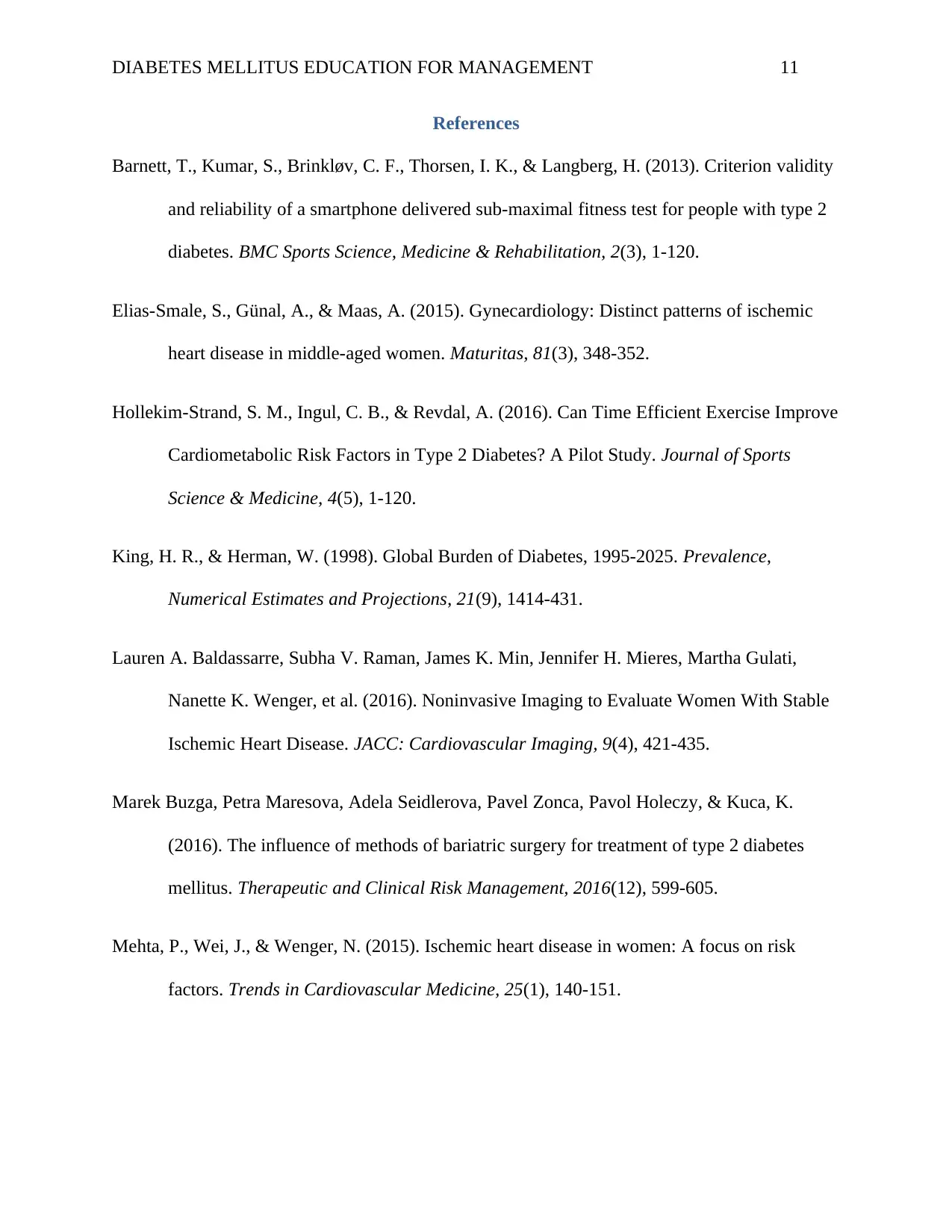
DIABETES MELLITUS EDUCATION FOR MANAGEMENT 11
References
Barnett, T., Kumar, S., Brinkløv, C. F., Thorsen, I. K., & Langberg, H. (2013). Criterion validity
and reliability of a smartphone delivered sub-maximal fitness test for people with type 2
diabetes. BMC Sports Science, Medicine & Rehabilitation, 2(3), 1-120.
Elias-Smale, S., Günal, A., & Maas, A. (2015). Gynecardiology: Distinct patterns of ischemic
heart disease in middle-aged women. Maturitas, 81(3), 348-352.
Hollekim-Strand, S. M., Ingul, C. B., & Revdal, A. (2016). Can Time Efficient Exercise Improve
Cardiometabolic Risk Factors in Type 2 Diabetes? A Pilot Study. Journal of Sports
Science & Medicine, 4(5), 1-120.
King, H. R., & Herman, W. (1998). Global Burden of Diabetes, 1995-2025. Prevalence,
Numerical Estimates and Projections, 21(9), 1414-431.
Lauren A. Baldassarre, Subha V. Raman, James K. Min, Jennifer H. Mieres, Martha Gulati,
Nanette K. Wenger, et al. (2016). Noninvasive Imaging to Evaluate Women With Stable
Ischemic Heart Disease. JACC: Cardiovascular Imaging, 9(4), 421-435.
Marek Buzga, Petra Maresova, Adela Seidlerova, Pavel Zonca, Pavol Holeczy, & Kuca, K.
(2016). The influence of methods of bariatric surgery for treatment of type 2 diabetes
mellitus. Therapeutic and Clinical Risk Management, 2016(12), 599-605.
Mehta, P., Wei, J., & Wenger, N. (2015). Ischemic heart disease in women: A focus on risk
factors. Trends in Cardiovascular Medicine, 25(1), 140-151.
References
Barnett, T., Kumar, S., Brinkløv, C. F., Thorsen, I. K., & Langberg, H. (2013). Criterion validity
and reliability of a smartphone delivered sub-maximal fitness test for people with type 2
diabetes. BMC Sports Science, Medicine & Rehabilitation, 2(3), 1-120.
Elias-Smale, S., Günal, A., & Maas, A. (2015). Gynecardiology: Distinct patterns of ischemic
heart disease in middle-aged women. Maturitas, 81(3), 348-352.
Hollekim-Strand, S. M., Ingul, C. B., & Revdal, A. (2016). Can Time Efficient Exercise Improve
Cardiometabolic Risk Factors in Type 2 Diabetes? A Pilot Study. Journal of Sports
Science & Medicine, 4(5), 1-120.
King, H. R., & Herman, W. (1998). Global Burden of Diabetes, 1995-2025. Prevalence,
Numerical Estimates and Projections, 21(9), 1414-431.
Lauren A. Baldassarre, Subha V. Raman, James K. Min, Jennifer H. Mieres, Martha Gulati,
Nanette K. Wenger, et al. (2016). Noninvasive Imaging to Evaluate Women With Stable
Ischemic Heart Disease. JACC: Cardiovascular Imaging, 9(4), 421-435.
Marek Buzga, Petra Maresova, Adela Seidlerova, Pavel Zonca, Pavol Holeczy, & Kuca, K.
(2016). The influence of methods of bariatric surgery for treatment of type 2 diabetes
mellitus. Therapeutic and Clinical Risk Management, 2016(12), 599-605.
Mehta, P., Wei, J., & Wenger, N. (2015). Ischemic heart disease in women: A focus on risk
factors. Trends in Cardiovascular Medicine, 25(1), 140-151.
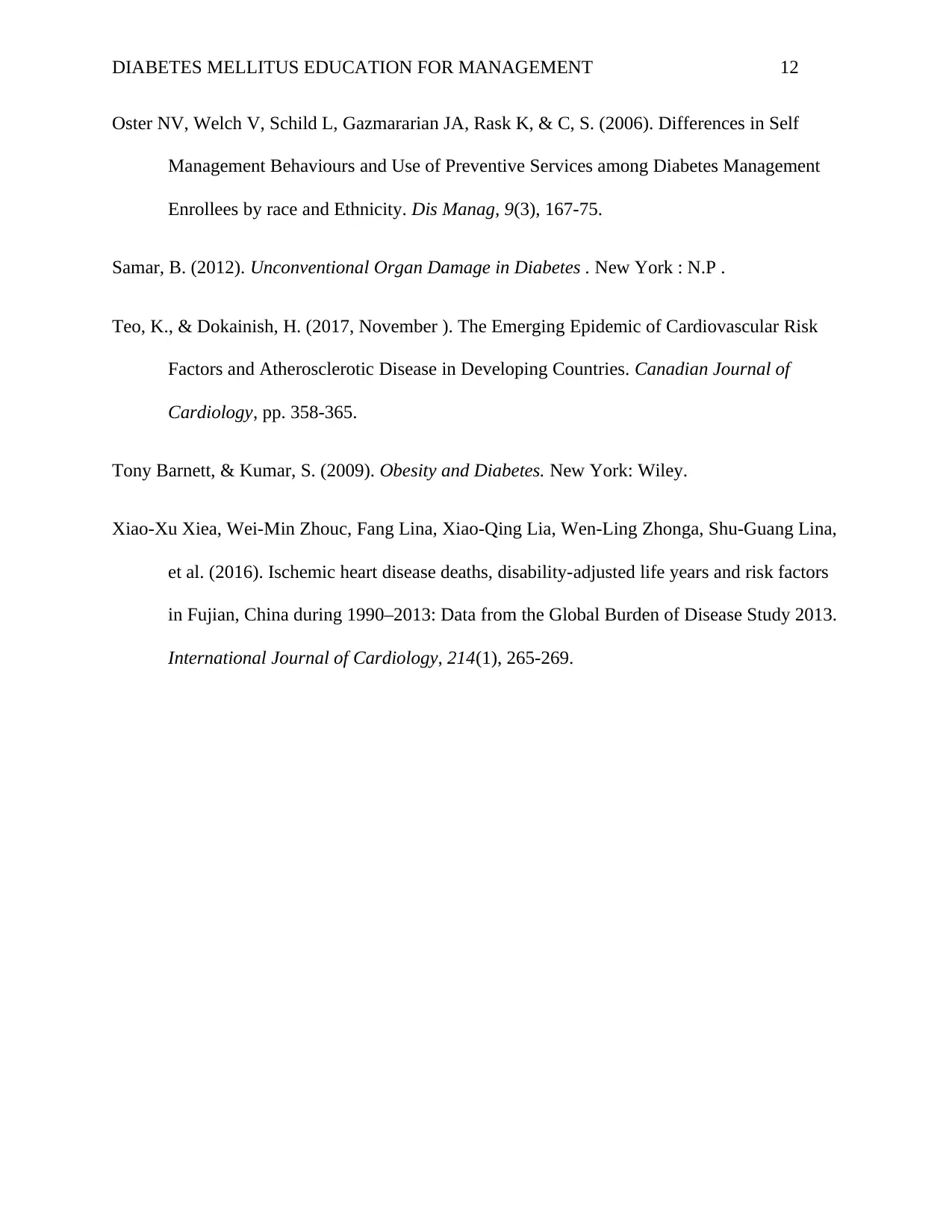
DIABETES MELLITUS EDUCATION FOR MANAGEMENT 12
Oster NV, Welch V, Schild L, Gazmararian JA, Rask K, & C, S. (2006). Differences in Self
Management Behaviours and Use of Preventive Services among Diabetes Management
Enrollees by race and Ethnicity. Dis Manag, 9(3), 167-75.
Samar, B. (2012). Unconventional Organ Damage in Diabetes . New York : N.P .
Teo, K., & Dokainish, H. (2017, November ). The Emerging Epidemic of Cardiovascular Risk
Factors and Atherosclerotic Disease in Developing Countries. Canadian Journal of
Cardiology, pp. 358-365.
Tony Barnett, & Kumar, S. (2009). Obesity and Diabetes. New York: Wiley.
Xiao-Xu Xiea, Wei-Min Zhouc, Fang Lina, Xiao-Qing Lia, Wen-Ling Zhonga, Shu-Guang Lina,
et al. (2016). Ischemic heart disease deaths, disability-adjusted life years and risk factors
in Fujian, China during 1990–2013: Data from the Global Burden of Disease Study 2013.
International Journal of Cardiology, 214(1), 265-269.
Oster NV, Welch V, Schild L, Gazmararian JA, Rask K, & C, S. (2006). Differences in Self
Management Behaviours and Use of Preventive Services among Diabetes Management
Enrollees by race and Ethnicity. Dis Manag, 9(3), 167-75.
Samar, B. (2012). Unconventional Organ Damage in Diabetes . New York : N.P .
Teo, K., & Dokainish, H. (2017, November ). The Emerging Epidemic of Cardiovascular Risk
Factors and Atherosclerotic Disease in Developing Countries. Canadian Journal of
Cardiology, pp. 358-365.
Tony Barnett, & Kumar, S. (2009). Obesity and Diabetes. New York: Wiley.
Xiao-Xu Xiea, Wei-Min Zhouc, Fang Lina, Xiao-Qing Lia, Wen-Ling Zhonga, Shu-Guang Lina,
et al. (2016). Ischemic heart disease deaths, disability-adjusted life years and risk factors
in Fujian, China during 1990–2013: Data from the Global Burden of Disease Study 2013.
International Journal of Cardiology, 214(1), 265-269.
⊘ This is a preview!⊘
Do you want full access?
Subscribe today to unlock all pages.

Trusted by 1+ million students worldwide
1 out of 12
Related Documents
Your All-in-One AI-Powered Toolkit for Academic Success.
+13062052269
info@desklib.com
Available 24*7 on WhatsApp / Email
![[object Object]](/_next/static/media/star-bottom.7253800d.svg)
Unlock your academic potential
Copyright © 2020–2025 A2Z Services. All Rights Reserved. Developed and managed by ZUCOL.





